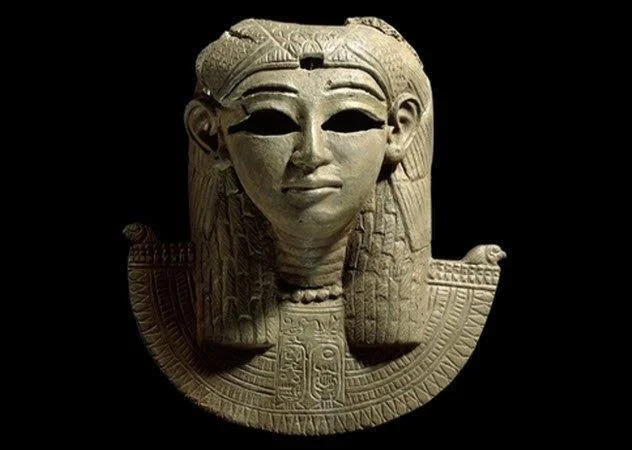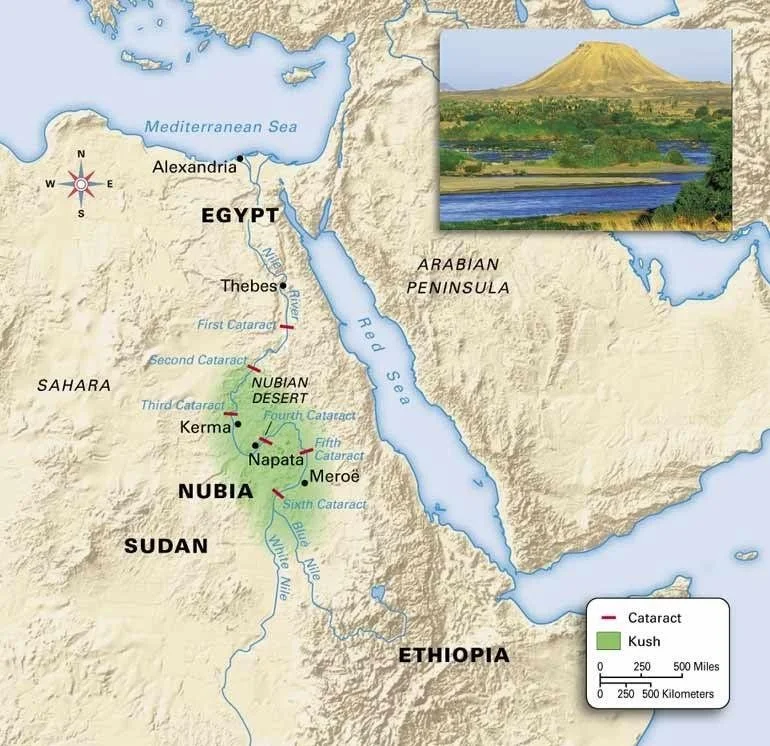The African Queen that Resisted Rome
As the neighbor to the south, Kush and Egypt were in close cultural ties since at least 2,400 BC. Their civilization dates back to around 8,000 BC, with an Empire that rivaled the Egyptians, sometimes even taking power over Lower (northern) Egypt.
From 800 BC, Kushite Kings ruled as Egyptian Pharaohs, until around 671 BC when the Assyrians took over Egypt. By 500 BC, Egyptians retaliated, saking their main city of Napate, moving their capital to the new city of Meroe, which would survive another thousand years. This powerful kingdom was driven by women.
In 40 BC, when Egypt’s Queen Cleaopatra had sons with two different Roman Emperors, Queen Amanirenas of Kush started her reign.
Amanirenas had both titles of qore [king] and kandake [queen]. Greeks and Romans mistook her title as queen (kandake) as her personal name, calling her Candace.
Many think queens can only rule if no surviving male lives, but it is understood she had both a husband and a son, as she remained fully in charge. She was also not the first Queen of Kush. Amanitore is also well known in her same century.
Royal women were also granted the power to order a king to commit suicide, a request that he was obliged to follow. These ruling women were called ÄòKandake or ÄòQore who ruled independent of a king and was responsible for leading her own army.
The Kingdom of Kush, also known as the Kingdom of Nubia, had at least 11 queens who ruled independently as monarchs, with 34 Queens known by name. The most well known all bear the important “Amen” part of the name, the god also known in Egyptian and Jewish (and subsequently) Christian religion: Amanirenas, Amanishakheto, and Amanitore (8 in total queens with this prefix):
Another name I found interesting was Asata, for its “AS” sound. She was a Nubian queen, but with the Egyptian titlesof: king's wife and Person of Egypt. This made me wonder if it was common for there to be intermarriage between the empires, and of course there was. Nubians married Egyptian women, and vice versa. Evidence suggests that Nubian men who settled in Egypt during the First Intermediate Period intermarried with Egyptian women, adopting Egyptian customs and burial practices. Similarly, there were Nubian queens who held positions of power in Egypt, indicating that Egyptian men also intermarried with Nubian women.
Asata is suspected to have been the wife of the Kush king Aspelta around 560 BC, when the Egyptians attacked Nubia. Asata is mainly known from her burial (Nuri 42, near the 4th cataract, or waterfall), a pyramid found heavily destroyed and looted. The chambers still contained a high number of objects, including the heart scarab of the queen, at least 270 shabtis providing her name and title, stone vessels, and amulets. Shabtis, also known as ushabtis, were small figures placed in tombs with ancient Egyptian mummies, which were believed to magically come to life and perform tasks for the deceased, like farming for the dead.
The earliest known pyramid at the Nubian site of Nuri belongs to king Taharqa, which was situated to watch the New Year’s sun rise from Jebel Barkal. The Egyptian New Year's Day also marked the beginning of the annual flooding of the Nile, and on this day, the sun would rise from the horizon directly over its point.
Of course, a church was erected here.[wiki] The church was built at least in part from reused pyramid stones, including several stelae originally coming from the pyramid chapels.
The hundred years between 40 BC and 50 AD saw 3x Kushite Queens in succession; Amanirenas, Amanishakheto and Amanitore. Amanirenas was the most prominent Kandake and reigned between for 30 years. She is most revered for defeating the Romans after a five -year war. She was initially victorious in her attempt to reclaim Roman Egypt for the Kingdom of Kush, before she was driven back by Petronius in 22 BC. She was recorded as being a brave warrior queen who terrified the Romans.
Roman author Strabo records that her ambassadors met with the Emperor and were granted all they desired from Rome.
After this, a peace treaty lasted between Rome and Nubia for almost 300 years.
Greeks and Romans used the term Ethiopians for people who lived beyond the city of Syene [modern Aswan], near to what was Egypt's southern border,
In the Nile at Syene lay the sacred island of Elephantine [today is part of Aswan] while to their south lay the island temple complex of Philae (related to our word “phallic”) dedicated to Isis, that was holy to both Egyptians and Nubians.
in 26 BC, the 'Ethiopians' of Kush (led by their Queen) invaded Egypt and attacked Syenê, taking Egypt’s southern cities of Elephantinê and Philae, and pulled down the statues of Caesar (who had a son with Egyptian Queen Cleopatra).
The treaty between Nubia and Rome settled the Empire's southern border, releasing occupied land in Kush and ensured that it would not pay tribute to Rome. Queen Amanirenas ruled until ca 10 AD while the treaty lasted until almost 300 AD. The Kingdom of Kush remained a major regional power into 400 AD.
What happened after the fall of the Kush Empire?
The Nuba people would give the land its modern name: Nubia. Egyptians referred to Nubia as “Ta-Seti” meaning “land of the bow” for their expert archers.
The ancestors of people in the Nile Valley (from 10k BC, Neolithic) likely came from Southern and Eastern Africa (Sudan and the Sahara). There was shared culture with the two areas and with that of Egypt during this time period. By 5,000 BC, the people who inhabited what is now called Nubia had their own revolution. Rock art in the Saharan Desert shows scenes thought to imply a religion that worshipped cattle, typical of those seen throughout the Nile Valley even to this day. Megaliths discovered at Nabta Playa are early examples of what seems to be one of the world’s first trackers of the stars, predating Stonehenge by almost 2,000 years. Many scholars believe these people to be the ones who started the Egyptian culture, first in Elephantine, then moving north along the flow of the Nile (as the Saharan desert dried out from jungle after 10k BC).
This complexity as observed at Nabta Playa likely formed the basis for the structure of both the Neolithic society at Nabta and the Old Kingdom of Egypt. Artifacts from the desert and the study of language and genetics show us the gradual development of Egyptian language and building techniques come from this area. Prior to this understanding, it was thought Egyptian culture sprang out of nowhere, which hardly ever happens.
Around 3,500 BC, the second “Nubian” culture arose, prior to Egypt’s first dynasty (2,920 BC). Naqada made an attempt to unify the whole Nile Valley. Once Ta-Seti (the kingdom of Qustul) was captured, Nubia became the first unified nome (separate governed section) of Upper Egypt.It was a contemporary of, and ethnically and culturally very similar to, the polities in predynastic Naqada of Upper Egypt. Around 3,300 BC, there is evidence of a unified kingdom, as shown by the finds at Qustul, that maintained substantial interactions (both cultural and genetic) with the culture of Naqadan Upper Egypt. The Nubian culture may have even contributed to the unification of the Nile Valley.
In 2,300 BC, Nubia was first mentioned in Old Kingdom Egyptian accounts of trade missions. From Aswan, right above the First Cataract, the southern limit of Egyptian control at the time, Egyptians imported gold, incense, ebony, copper, ivory, and exotic animals from tropical Africa through Nubia.
Nubia is believed to have served as a trade corridor between Egypt and tropical Africa long before 3100 BC. Egyptian craftsmen of the period used ivory and ebony wood from tropical Africa which came through Nubia.
Temperature shifts can be blamed for times of most trouble, due to famine, but also an influx of various groups from the deeper Saharan desert, particularly around 2,200 BC, when they saw various waves of invaders.
During the Egyptian Middle Kingdom (c. 2040–1640 BC), Egypt began expanding into Nubia to gain more control over the trade routes through Nubia.
“The 12th Egyptian Dynasty (1,991–1,786 BC) originated from the Aswan (southern) region. As expected, strong Nubian features and dark coloring are seen in their sculpture and relief work. This dynasty ranks as among the greatest." -(Yurco 1989)
In 1,750 BC, the Nubians (Kings of Kerma) attacked Egypt in an act that was so devastating, that they might have had the chance to bring all of the Egyptian empire to extinction.
In the New Kingdom (1,550 to 1,069 BC), The Egyptians destroyed Kerma’s kingdom and capitol and expanded the Egyptian empire to the Fourth Cataract.
After this, Nubians and Egyptians were often so closely related that some scholars consider them virtually indistinguishable, as the two cultures melded and mixed together.
By the end of the reign of Thutmose I (1,520 BC), all of northern Nubia had been conquered by Egypt. The Egyptians built a new administrative center at Napata, and used the area to produce gold. The Nubian gold production made Egypt a prime source of the precious metal in the Middle East. The primitive working conditions for the slaves are recorded by Diodorus Siculus who saw some of the mines at a later time. One of the oldest maps known is of a gold mine in Nubia, the Turin Papyrus Map dating to about 1,160 BC.
in the 1100’s BC, Egyptian rulers were pushed out of Kush. In the Kushite Period, when Nubians ruled as Pharaohs in their own right, the material culture of Dynasty 15 (about 750–655 BC) was decidedly Egyptian in character. Nubia’s entire landscape up to the region of the Third Cataract was dotted with temples indistinguishable in style and decoration from contemporary temples erected in Egypt. The Kushites held sway over their northern neighbors for nearly 100 years, until they were eventually repelled by the invading Assyrians. The Assyrians forced them to move farther south, where they eventually established their capital at Meroë.
The oldest evidence of Nubian rulers used royal symbols related to those used by Egyptian pharaohs. There were also similarities in rock art to support this position. In some eras, Egypt conquered Nubia, and in others, the Nubians ruled over Egypt (like in the 25th Dynasty). Even so, relations between the two peoples also show peaceful cultural interchange and cooperation, including mixed marriages.





